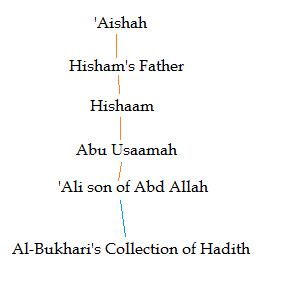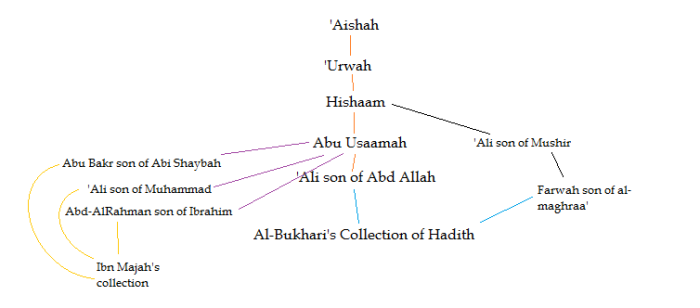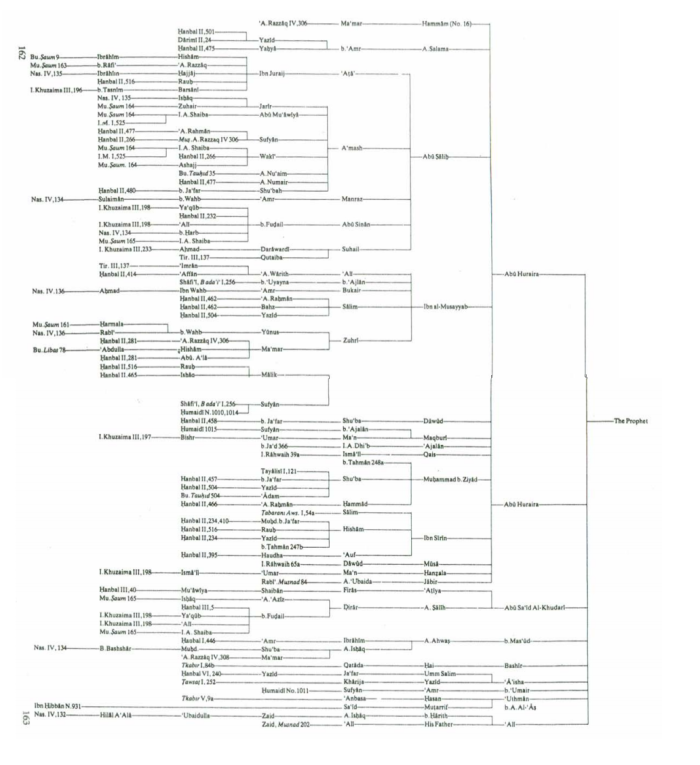Some time after the death of the Prophet, a need arose among the Muslims for an authentic source for the beliefs and ritual practices of the Prophet Muhammad (ص). The Qur’an, which was undoubtedly considered authentic and authoritative among all Muslims, did not provide much information about Muslim practice and Law. Indeed, it is the Hadith, that is, the sayings and actions of the Prophet Muhammad (ص), that provides the bulk of the raw material for Islamic jurists past and present. After the death of the companions and the generation who succeeded them, there arose a new challenge facing the ranks of the Muslim jurists. All those who had personal contact with the Prophet had passed away: There was no longer any early figures to tell the Muslims what the authentic teachings of the Prophet was. Forgery also became a huge problem in the Islamic lands: Sectarian and political turmoil produced an environment where putting words in the mouth of the Prophet to support one’s own cause was common. So how did Muslim scholars of Hadith, the Muhaddithoon, sift through the masses of Prophetic reports to single out the authentic ones?
1. Demand a source.
The first step to filtering out useless traditions is to ask the narrator for a source on his Hadith. Ideally, the man (or woman) should be able to provide an Isnaad. The word “Isnaad” in Arabic means “support” and it is in effect a chain of narrations from the reporter back to the Prophet. Lets look at an example. There is a hadith found in Sahih Al-Bukhari, which goes by this text (called the matn):
كَانَ النَّبِيُّ صلى الله عليه وسلم يُعْجِبُهُ الْحَلْوَاءُ وَالْعَسَلُ.
“The Prophet, may the blessings of God and peace be upon him, used to like eating sweets and honey.”
An isnaad for this text is provided by Al-Bukhari:
حَدَّثَنَا عَلِيُّ بْنُ عَبْدِ اللَّهِ، حَدَّثَنَا أَبُو أُسَامَةَ، قَالَ أَخْبَرَنِي هِشَامٌ، عَنْ أَبِيهِ، عَنْ عَائِشَةَ ـ رضى الله عنها
‘Ali ibn Abdullah narrated from Abu Usaamah who said Hishaam told me from his father who reported from ‘Aishah.
Perhaps it is more intuitive to represent this isnaad on a diagram:  If the narrator is able to provide an isnaad like the one seen above, he has passed the first layer of the critical method. Note that right now his report is only a little better than hearsay. Did the Prophet Muhammad (ص) really have a sweet tooth? We still don’t know: Several other steps remain for us to take before declaring the report as useful.
If the narrator is able to provide an isnaad like the one seen above, he has passed the first layer of the critical method. Note that right now his report is only a little better than hearsay. Did the Prophet Muhammad (ص) really have a sweet tooth? We still don’t know: Several other steps remain for us to take before declaring the report as useful.
EDIT 1/1/15 : Hisham’s father’s name is ‘Urwah, and the next diagram reflects this change.
2. Criticize the source
As you probably can already tell, asking for a source doesn’t deter a forger. Anyone could make up an isnaad. The names could be just something the forger thought up of on the spot- or, if he were taking a bit more care, looked at examples of good narrators and simply strung them up in a somewhat believable order of narration. Enter the next step of Hadith evaluation: Isnaad Criticism. The critic’s job was to scrutinize the isnaad itself to see whether it was actually plausibly represented a real transmission of the report. They did this in several ways:
1. Biographical evaluation.
A very useful weapon in the Muhaddith’s toolbox was the massive biographical tomes that historians and hadith scholars produced. They listed the birth/death dates of narrators, a brief description of their lives (if available), their geographical locations, their students and their teachers, among other useful information. The usefulness of these books has been stressed by many scholars past and present. Says Hassan b. Zayd, “We never used against the forgers any device more effective than the Ta’rikh (historical/chronological information).” From these books, a scholar will find out whether:
1. There is any information confirming that these people in the isnaad actually existed. If the narrator is not found in any of the biographical dictionaries, then there is a risk that the name is simply invented; the chain would therefore be considered weak. Another way of confirming the existence of someone is when he is quoted by name by several well-known sources of Hadith.
2. The lives of the people in the Isnaad actually overlapped. It is very difficult to place confidence in a chain where one of the narrators was born 30 years after the death of the person he supposedly heard the report from!
2. Their biographical situations make it plausible that these transmitters in the chain would report from each other.
In summary, what scholars want to see is whether the isnaad actually makes sense. Ofcourse, some scholars would have stricter standards than the points mentioned above: Al-Bukhari, for example, wanted positive proof that the narrators met from those they said they heard from: it was not enough for him that they lived in the same general area, or that their lives overlapped.
2. Transmitter evaluation
The individual reliability of the narrators was another thing that the scholars of Hadith were on the look out for. The hadith scholar had to go through all the reports of the narrators in the isnaad and check whether they were reliable sources of information.
Lets look at Abu Usaamah as an example. How do we find out whether this man is reliable? One of the primary methods is looking for ‘multiple attestation’ among his reports. This means, if Abu Usaamah heard a Hadith from Hishaam, do we see that same Hadith being reported by the other students of Hishaam? It would only be logical that this be the case, if Abu Usaamah is telling the truth. Lets say for example, you’ve missed a class on one of your course subjects. You ask one of the attendees, named Zayd, this question: “Was there anything important in the lecture?” to which he replies, “X topic won’t appear on the final exam”. You then ask five other attendees about this matter- and you see that they don’t say anything of the sort; even though they should have actually heard this if the lecturer said it. Zayd’s report doesn’t spark much confidence now: we should play it safe and say Zayd is probably lying or he misheard the lecturer.
The scholar Muslim bin al-Hajjaj says this plainly:
“[A weak hadith transmitter is] when his narrations are compared to those of people known for preservation of Hadith and uprightness of character, his narrations do not concur with their narrations, or do so only rarely. If the majority of his hadiths are like that then he is rejected and not used in hadith.”
Other criterion for transmitter evaluation is the religiosity and piety of a transmitter. One cannot at any cost accept the report of someone who has already been shown to be a liar and forger of Hadith. For a very good isnaad, all the narrators would ideally be scholars who are known for their practice and devotion to Islam. In this case the critics are somewhat flexible, after all, an expert forger would try his best to look like a devoted Muslim. Furthermore, even religious people can easily make mistakes- or forge material “for a good cause” as is the case for many ascetic forgers. Pious forgery is a well known phenomenon in religious traditions outside Islam too. Al-San’ani points out that accuracy (based on the multiple attestation criterion above) is far more important than uprightness.
3. Look for corroboration of the source
This is arguably the most important part of Hadith criticism, and it is after this stage can a report of the Prophet actually inspire some confidence in the eyes of the hadith scholar. The scholar now looks at all the isnaads of the Hadith and see whether there is a lot of different sources saying the same thing. If lots and lots of people attest to a report, and all these people’s reports really do trace back to the eyewitnesses, then we can have good confidence in the report. In Western historical evaluation this is called the criterion of multiple attestation. This is probably best explained via demonstration. Lets look back at our diagram earlier. We will now introduce some more sources. These are by no means exhaustive, I’ll only be bringing a few more isnaads in for the sake of demonstration.  The new diagram introduces some isnaads found in the Sunan of Ibn Majah as well another Isnaad found in Sahih Al-Bukhari. As I have stressed earlier, there are far more isnaads than this in reality. We see that the Hadith is well corroborated at the point of Abu Usaamah. Four people claim to have heard directly from him. It probably is the case that Abu Usaamah really did say this. Can we move up further? Probably: Hishaam, too, is multiply attested. A certain ‘Ali also corroborates Abu Usaamah’s report from Hishaam. Just by looking at these isnaads alone, we have some confidence that Hishaam said this. What remains now is to look for some sort of corroboration for Hishaam’s hearing from ‘Urwah. This will not be done in the present article: but if it is found, it will give some credit to ‘Urwah’s statement too. Since ‘Aisha alone would probably be the one who narrates about the Prophet’s preference in food, since she was one of his closest wives and the only one of them that became a major Hadith transmitter, we will probably take her word for it without looking for any corroboration from the Prophet’s other wives. Sunni dogma aside, it is unlikely that she would lie about the Prophet’s love of sweet food. A more complete example of the transmission of Hadith can be seen in this diagram from Al-Azami’s book. This time it concerns the love that God has for the believer that fasts and abstains from minor sins during it for His sake.
The new diagram introduces some isnaads found in the Sunan of Ibn Majah as well another Isnaad found in Sahih Al-Bukhari. As I have stressed earlier, there are far more isnaads than this in reality. We see that the Hadith is well corroborated at the point of Abu Usaamah. Four people claim to have heard directly from him. It probably is the case that Abu Usaamah really did say this. Can we move up further? Probably: Hishaam, too, is multiply attested. A certain ‘Ali also corroborates Abu Usaamah’s report from Hishaam. Just by looking at these isnaads alone, we have some confidence that Hishaam said this. What remains now is to look for some sort of corroboration for Hishaam’s hearing from ‘Urwah. This will not be done in the present article: but if it is found, it will give some credit to ‘Urwah’s statement too. Since ‘Aisha alone would probably be the one who narrates about the Prophet’s preference in food, since she was one of his closest wives and the only one of them that became a major Hadith transmitter, we will probably take her word for it without looking for any corroboration from the Prophet’s other wives. Sunni dogma aside, it is unlikely that she would lie about the Prophet’s love of sweet food. A more complete example of the transmission of Hadith can be seen in this diagram from Al-Azami’s book. This time it concerns the love that God has for the believer that fasts and abstains from minor sins during it for His sake.  P
P
The Isnaad bundle that ‘Azami has rendered above gives us very good confidence in a Hadith report. We can see a large amount of attestation: it is hard to believe that this report is forged. The hadith appears in Madinah, Basra, Kufa, Mecca, Wasit, the Hijaaz, and Khurasaan at the 3rd level of the isnaads. It is widely multiply attested; some scholars would give it the “mutawaatir” grade.
Perhaps I’ll edit this article to look for more Isnaads to corroborate our report on the Prophet’s liking for sweets, but for now, I hope this has given the reader a brief overview as to how Hadith criticism is done. And God knows best.
Bibliography:
Al-Azami, Mustafa. Studies in Hadith Methodology and Literature. 2002.
Zubayr Siddiqi, Muhammad. Hadith Literature: Its Origin, Development, Special Features and Criticism. 2006
Brown, Jonathan Hadith: Muhammad’s Legacy to the Medieval and Modern World. 2009
Al-Azami, Mustafa. On Schacht’s Origins of Muhammadan Jurisprudence. 1996
Notes: This article approaches the topic of discussion the format of the “Three-tiered method” of Sunni Hadith Criticism that is introduced in Jonathan Brown’s “Hadith: Muhammad’s Legacy to the Medieval and Modern World”, but I have used more books (listed in the bibliography) to supplement this text. The so called three tiered method is only presented this way for ease of presentation, the Muhaddithoon don’t consciously call it that.
Reblogged this on Blogging Theology and commented:
Interesting…
LikeLike
Good article, thanks..
LikeLike
why not use the letter ‘e’ for the ‘e’ sound? ie hadeth? Why confuse readers by using
‘i’ which does not usually have the ‘e’ sound?
LikeLike
Thank you for this! Jazakallah.
LikeLiked by 1 person
Thanks much for this.
Very concise and clear.
I have an important question.
I noticed that in the example you gave, the first two attributed narrators do not have corroboration.
Do you know what percentage of hadiths judged to be authentic have corroboration in the first attributed narrator (the companion stage)?
And at the second stage (the successor stage)?
LikeLike
Salam Taha,
Can I use this post?
Is your email still tuahaa.soomro@gmail.com
LikeLike
Assalam alaikum wrwb brother Taha,
I was studying the method of hadith criticism and found that scholars have stipulated 5 conditions for a hadith to be Sahih.these are
e:
‘Adaalah (العدالة) – For each narrator of its chain to be upright in character.
Dhabt (الضبط) – For each narrator of its chain to be precise in transmitting its content.
Ittisaal (الاتصال) – For each narrator of the chain to be known.
‘Illah Qadiha (العلة القادحة) – For the hadith to be free from a significant, yet hidden defect within the chain or content of the hadith.
Shaath (الشاذ) – For the hadith to not be anomalous due its chain or content.
Well I found that the point 1 ( adlah /integrity ) is very rigid. and scholars are lenient towards accuracy (dabt) where i think from a historical perspective it should be other way around.
See If a narrator is sinful like a drunkard /fraud or commits minor sins repeatedly it makes sense to discard his credibility.But what i learnt that narrators had been discarded for doing minor things like walking while eating and things that are the people around him find wierd but it is not makroor or hamram in quran and hadith.
from this source “http://ilmfruits.com/2008/conditions-for-saheeh-hadeeth/”
”The sub-conditions for ‘adaalah is that the narrator fears Allah, they are not known to commit major sins or consistent minor sins, and that they avoid all that people may consider shameful (faqawaar al-maroo’a). A modern day example of this would be that the Imam of the masjid would not come lead the prayer in shorts. Although shorts are technically fine to wear, some members of the prayer may consider it shameful and inappropriate for the Imam to lead the prayer in such clothing. So the narrators leave acts that can be seen as shameful by the people, even if they are not haraam or makrooh.”
While disobeying Quran and sunnah makes sense but I could not understand the wisdom behind rejecting a scholar on the basis of local customs(faqawaar al-maroo’a).I guess the wisdom behind that if a narrator is careless to adhere to the decorum then he must be careless in narrating the hadith
But on the contrary, It can be argued that they were doing the things which are not approved by the local custom ( but ok according to quran and hadith) to stress on focusing on quran and sunnah alone rather than focuing on local wossol which they might see as a biddah.(or a custom based on weak hadith)
Am I missing something?
I tried to find the source describing the concept and criteria of “Adalahh ” more comprehensively but could not find any source(web or e book). I would be glad if u give ur insight in this case
LikeLike